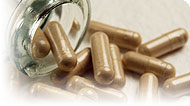Penn Herb Wellness Guide
Pine Bark Extract (Pycnogenol)Find Products

- Reliable and relatively consistent scientific data showing a substantial health benefit.
- Contradictory, insufficient, or preliminary studies suggesting a health benefit or minimal health benefit.
- For an herb, supported by traditional use but minimal or no scientific evidence. For a supplement,little scientific support.
Our proprietary “Star-Rating” system was developed to help you easily understand the amount of scientific support behind each supplement in relation to a specific health condition. While there is no way to predict whether a vitamin, mineral, or herb will successfully treat or prevent associated health conditions, our unique ratings tell you how well these supplements are understood by the medical community, and whether studies have found them to be effective for other people.
For over a decade, our team has combed through thousands of research articles published in reputable journals. To help you make educated decisions, and to better understand controversial or confusing supplements, our medical experts have digested the science into these three easy-to-follow ratings. We hope this provides you with a helpful resource to make informed decisions towards your health and well-being.
This supplement has been used in connection with the following health conditions:
| Used for | Amount | Why |
|---|---|---|
Chronic Venous Insufficiency | 150 to 300 mg per day | A controlled study reported that supplementingdaily with Pycnogenol improved symptoms of chronic venous insufficiency and reduced associated leg swelling.
|
Hypertension | 150 to 200 mg per day | Pine bark extract, often referred to by the trademark name Pycnogenol®, has been shown to reduce systolic blood pressure in people with mild hypertension. |
Retinopathy | 120 to 150 mg per day | Preliminary and double blind studies have shown that daily supplementation withPycnogenol may slow the progression of retinopathy and improve vision.
|
Age-Related Cognitive Decline | 150 mg per day | A study of healthy senior people reported that supplementing daily with Pycnogenolimproved some measures of memory after three months, compared with a group taking a placebo.
|
Asthma | 1 mg per pound of body weight per day, in two divided doses | In one trial, supplementing with Pycnogenol improved lung function and asthma symptoms and reduced the need for rescue medication in children with asthma.
|
Attention DeficitHyperactivity Disorder | 1 mg daily per 2.2 pounds body weight daily | Though another story did not find effect, onestudy reported that Pycnogenol reduced symptoms of hyperactivity and improved attention, coordination, and concentration after one month in a group of children with ADHD.
|
Dysmenorrhea | 60 mg per day | Preliminary research and double-blind research has reported that pycnogenol may reduce severe abdominal and back pain during menses.
|
Erectile Dysfunction | 120 mg daily | In one study of men with erectile dysfunction, supplementing with Pycnogenol improved erectile function.
|
Gingivitis | 6 pieces chewing gum per day containing 5 mg each | In a double blind trial, people with gingivitis whochewed six pieces daily of a gum had less gum bleeding and no additional plaque formation, compared with a placebo group.
|
Jet Lag | 150 mg per day for seven days, beginning two days before travel | In controlled studies, Pycnogenol taken fortwo days before and five days after air travel led tomilder symptoms that lasted for a shorter period of time, compared with untreated control groups.
|
Lupus | 60 to 120 mg per day | In a small, controlled study, Pycnogenolseemed to help decreasesystemic lupus erythematosus activity, measured with a combination of signs, symptoms, and blood measurements.
|
Menopause | 60 to 200 mg per day | In a double-blind trial, perimenopausal women who took Pycnogenol experienced reduced menopause symptoms.
|
Osteoarthritis | 100 to 150 mg per day | Double-blindresearch has shown thatPycnogenol may improve symptoms of osteoarthritis, including reducing pain and the use of pain-relieving medication andimproving walking performance.
|
Skin Ulcers | 150 mg per day orally, along with topical application of 100 mg daily | In a controlled study, symptoms of diabetic skin ulcersimproved in those treated with standard medications plus oral and topical Pycnogenol.
|
Sunburn | 1.1 to 1.66 mg per 2.2 lbs (1 kg) of body weight per day during periods of high sun exposure | Proanthocyanidins (flavonoids found in pine bark, grape seed, and other plant sources) may increase the amount of ultraviolet rays necessary to cause sunburn.
|
Type 2 Diabetes | 100 to 200 mg daily | Pycnogenol may improve blood glucose control and help prevent diabetes complications such as retinopathy in people with type 2 diabetes. |
Venous Thrombosis | For plane travel: 200 mg two to three hours before a flight, 200 mg six hours later, and 100 mg on the following day | People at risk for venous thrombosis during plane travel were shown a video explaining in-flight exercises to prevent venous thrombosis and also followed a regimen of Pycnogenol, which appears to reduce frequency of episodes of venous thrombosis. |
Endometriosis | 60 mg per day | In a preliminary study, symptoms of endometriosis gradually declined when women took Pycnogenol.
|
High Cholesterol | 50 to 450 mg per day | Pycnogenol appears unlikely to impact cholesterol levels. |
Leg Cramps | Refer to label instructions | A preliminary study of people experiencing at least four episodes per week of leg cramps due to either athletic activity, circulatory disorders, or unknown causes reported that Pycnogenol significantly reduced cramping.
|
Melasma | 75 mg per day | Preliminary research shows that melasma, a disorder of increased skin pigmentation, may be improved by Pycnogenol supplementation.
|
Pregnancy and Postpartum Support | 30 mg per day | In a controlled study, pregnant women who took Pycnogenol reported some relief of pain in the legs, pelvis, hip, and low back.
|
Traditional Use (May Not Be Supported by Scientific Studies)
Copyright 2025 TraceGains, Inc. All rights reserved.
Learn more about TraceGains, the company.
The information presented by TraceGains is for informational purposes only. It is based on scientific studies (human, animal, or in vitro), clinical experience, or traditional usage as cited in each article. The results reported may not necessarily occur in all individuals. Self-treatment is not recommended for life-threatening conditions that require medical treatment under a doctor's care. For many of the conditions discussed, treatment with prescription or over the counter medication is also available. Consult your doctor, practitioner, and/or pharmacist for any health problem and before using any supplements or before making any changes in prescribed medications. Information expires December 2025.


